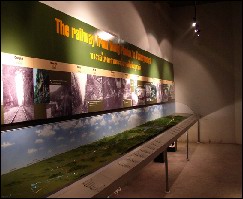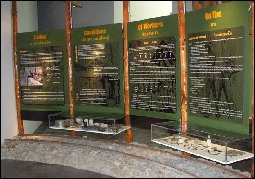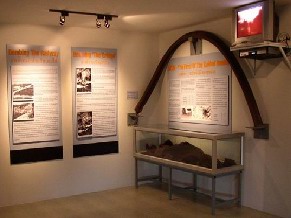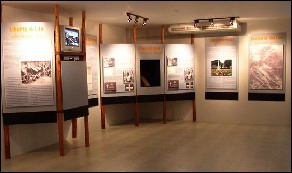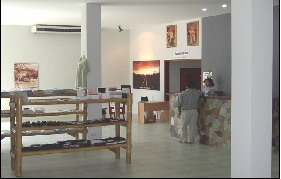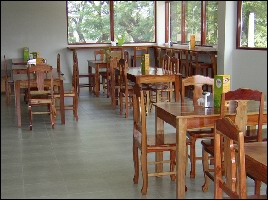CENTRE FACILITIES | ||||||||||||||||
|
MUSEUM The Museum area tells the story of the Thailand-Burma Railway in a respectful, factual and non-partisan way by using state-of the art display techniques. There are eight main galleries. Introduction / Timeline
The visitor enters the museum area under a wooden bridge mockup constructed using exactly the same techniques used to build the bridges on the railway. Gallery panels describe the Japanese invasion of Southeast Asia and the capture of prisoners. A lightbox displays the dispersal of Allied prisoners after capture. Further panels discuss the planning of the route. The visitor then passes through a mockup of one of the "rice wagon" railway boxcars used to transport prisoners from Singapore and Malaya to Thailand. An electronic route map, using fibre optic lighting to display the actual routes taken, is located in the boxcar. Planning, Construction And Logistics
This gallery details the techniques used by the Japanese engineers to plan, design, and build the railway. Gallery panels compare the resourcefulness of the Japanese engineers with the actual hard labour methods of construction. Particular attention is drawn to the fact that the railway was constructed using manual labour - very little heavy equipment was used. The gallery contains actual relics of construction tools used, recovered from the route of the railway in the late 1990's. The Geography Of The Railway
The Geography gallery is almost entirely visual in content. A video display shows footage of areas of the railway line. One of the museum's major features, the 9 metre long 1:50 ,000 scale contour model, is situated here. This model uses fibre optic track lighting to show the route of the railway through the River Kwae valley. User-controlled LED lights pinpoint the confirmed locations of all of the work camps along the railway. Graphic panels show wartime and present day images of the line. A trestle bridge model, track and bridge relics complete the display. Living Conditions
Five panels describe the movement, accommodation, and food supplies of the prisoners, and compare the different conditions in each work area with the chances of survival of the workers. One panel is dedicated to describing the infamous "Speedo" period between March and September 1943, when the majority of deaths occurred. The gallery also contains two showcases displaying relics of personal effects found along the railway trace. Medical Aspects The Medical Aspects gallery takes the form of a hospital hut mockup. Two major panels, Doctors, Disease And Despair and Medical Improvisation, describe the amazing resourcefulness, dedication and bravery of the doctors and medical orderlies who did their utmost to care for the men in their trust. The text is supported by reconstructions of some of the improvised medical equipment used. Summary Of Deaths The Summary Of Deaths gallery shows in graphic detail the human cost of constructing the railway. Detailed analysis of deaths by origin is supported by a histogram made from old railway sleepers studded with rail spikes. Each spike represents five hundred souls. The End Of The Railway
There are three elements to this large gallery on the first floor. The first part of the gallery describes the short time that the railway was effectively used by the Japanese forces to transport men and equipment to and from Burma. The gallery then relates the changing conditions of the war in the Pacific theatre, as the Allies gained the upper hand, and the subsequent bombing of the railway. The final part of the gallery describes the defeat of the Japanese forces and the liberation of the prisoners and Asian conscripts. Major display features in this area include a 3 metre deep model of a railway cutting being constructed at night, the almost complete AZON bomb held in a showcase, and a section of bomb damaged rail recovered from the railway trace. A video clip clearly shows AZON bombs (the world's first guided weapon) attacking and destroying a bridge on the railway. After The War
The final gallery focuses on the human experience of liberation from the ordeal of captivity and slave labour, the repatriation of Allied prisoners and Asian conscripts, the search for and recovery of bodies, the establishment of the war cemeteries in Kanchanaburi and Thanbyuzayat (Myanmar), and the final sale of the railway line to the Thai authorities in 1947. RECEPTION AND SHOP
Visitors to the Centre may pass through the shop before or after entering the Museum. The shop offers a variety of merchandise, including books on the railway and the Second World War, local handicrafts and a unique range of hand made products by the Weaving For Women Project in Sangklaburi. The shop area also serves as the reception area for visitors to the Centre. COFFEE SHOP & CAFE
Coffee and other hot beverages, water, beer, soft drinks, milk shakes, ice cream and confectionery are available in the first floor coffee shop, which has a seating capacity of over 50. A range of hot and cold food is also available including burgers, open grills, sandwiches, hot dogs, toast, raisin toast, rice dishes, steamed dim sims (dim sum) and cakes. Entry to the Coffee Shop/Cafe is available to the general public, with or without entry to the Museum, for breakfast (e.g. Bacon & Eggs), hot or cold lunch or just a snack while relaxing in air-conditioned comfort. With a friendly atmosphere and panoramic view of the beautifully kept gardens of the adjacent War Cemetery the facilities are often used by ex PoW's and/or their families as a home-away-from-home and perhaps some quiet reflection during their pilgrimages to Kanchanaburi.
|
|||||||||||||||


